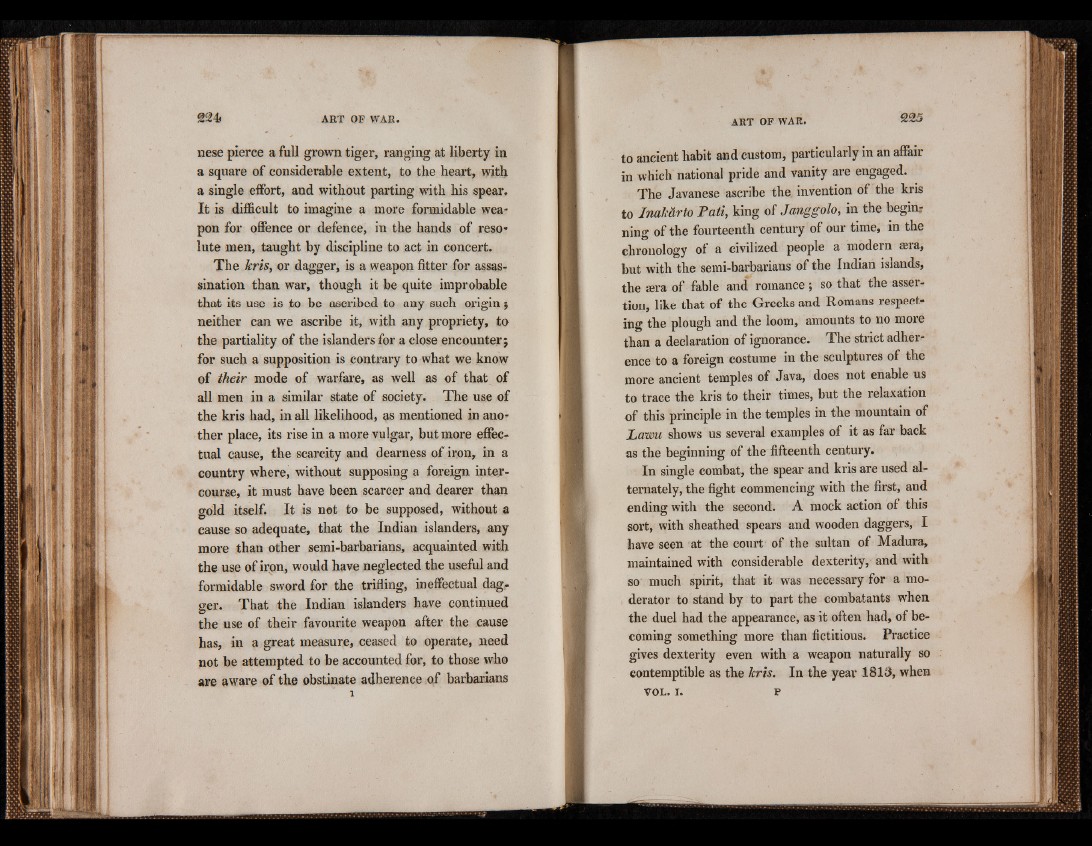
nese pierce a full grown tiger, ranging at liberty in
a square of considerable extent, to the heart, with
a single effort, and without parting with his spear.
It is difficult to imagine a more formidable weapon
for offence or defence, in the hands of resolute
men, taught by discipline to act in concert.
The kris, or dagger, is a weapon fitter for assassination
than war, though it be quite improbable
that its use is to be ascribed to any such origin;
neither can we ascribe it, with any propriety, to
the partiality of the islanders for a close encounter;
for such a supposition is contrary to what we know
of their mode of warfare, as well as of that of
all men in a similar state of society. The use of
the kris had, in all likelihood, as mentioned in another
place, its rise in a more vulgar, but more effectual
cause, the scarcity and dearness of iron, in a
country where, without supposing a foreign intercourse,
it must have been scarcer and dearer than
gold itself. It is not to be supposed, without a
cause so adequate, that the Indian islanders, any
more than other semi-barbarians, acquainted with
the use of iron, would have neglected the useful and
formidable sword for the trifling, ineffectual dagger.
That the Indian islanders have continued
the use of their favourite weapon after the cause
has, in a great measure, ceased to operate, need
not be attempted to be accounted for, to those who
are aware of the obstinate adherence of barbarians
to ancient habit and custom, particularly in an affair
in which national pride and vanity are engaged.
The Javanese ascribe the invention of the kris
to Inakarto Pali, king of Janggolo, in the begin;
ning of the fourteenth century of our time, in the
chronology of a civilized people a modern sera,
but with the semi-barbarians of the Indian islands,
the sera of fable and romance; so that the assertion,
like that of the Greeks and Romans respecting
the plough and the loom, amounts to no more
than a declaration of ignorance. The strict adherence
to a foreign costume in the sculptures of the
more ancient temples of Java, does not enable us
to trace the kris to their times, but the relaxation
of this principle in the temples in the mountain of
Lawn shows us several examples of it as far back
as the beginning of the fifteenth century.
In single combat, the spear and kris are used alternately,
the fight commencing with the first, and
ending with the second. A mock action of this
sort, with sheathed spears and wooden daggers, I
have seen at the court of the sultan of Madura,
maintained with considerable dexterity, and with
so much spirit, that it was necessary for a moderator
to stand by to part the combatants when
the duel had the appearance, as it often had, of becoming
something more than fictitious. Practice
gives dexterity even with a weapon naturally so
contemptible as the kris. In the year 1813, when
VOL. i. p